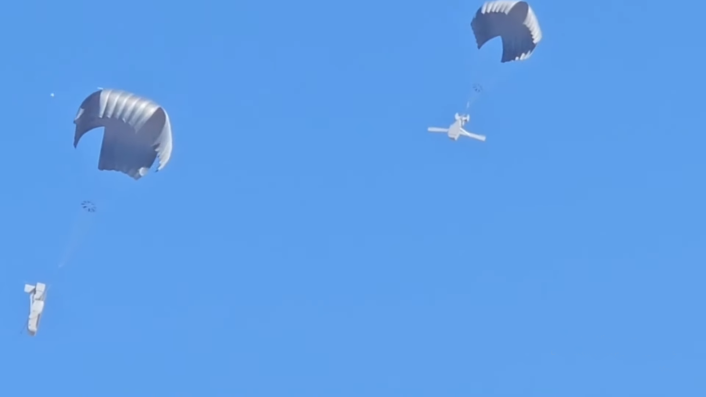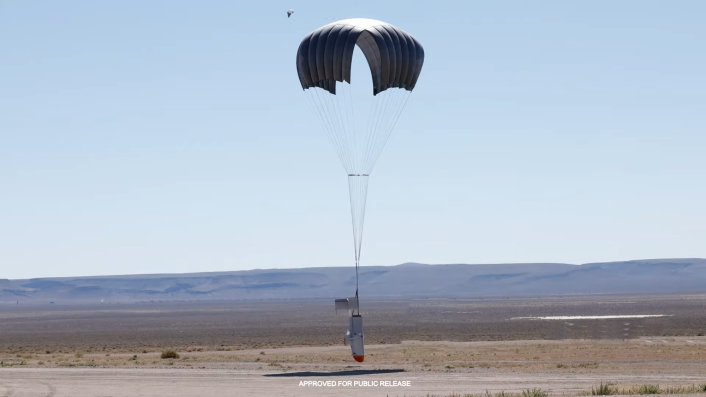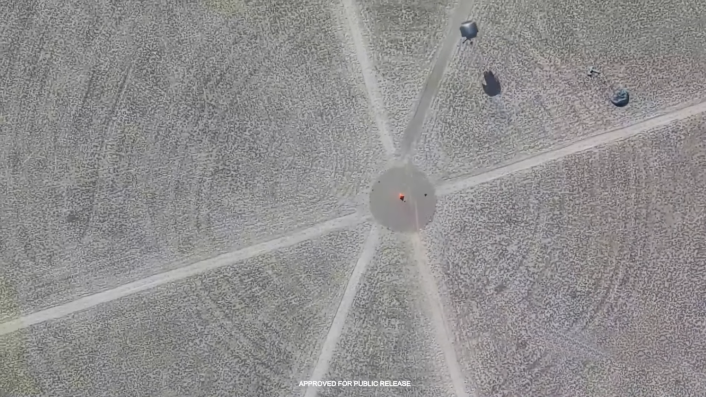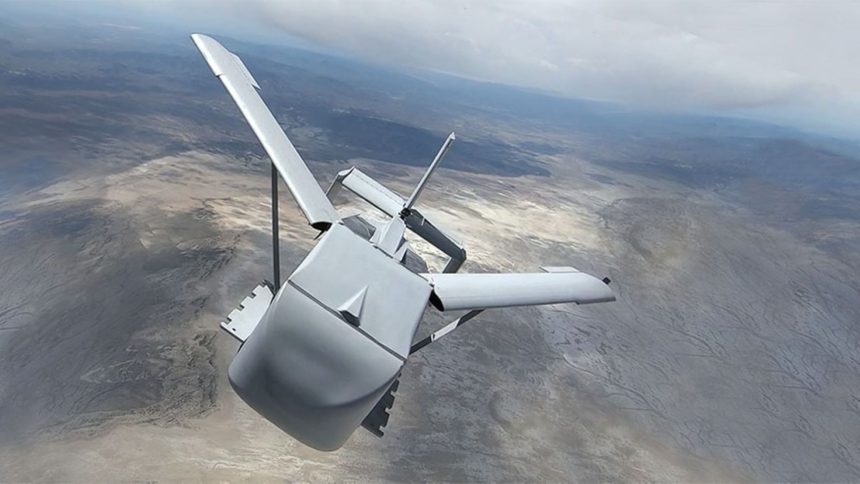AFRL and the developer DZYNE said the Grasshopper offers low-cost standoff cargo delivery and troop resupply in contested, high-risk environments
The U.S. Air Force has received “several dozen” units of the Grasshopper autonomously-navigated gliders that will substitute larger manned aircraft for cargo deliveries in risky, air-defended environments, officials from contractor DZYNE told Air and Space Forces Magazine. Developed in collaboration with the Air Force Research Laboratory (AFRL), the system was unveiled on May 2, 2025, and “is part of a broader ongoing program to enhance contested logistics capabilities,” a release from DZYNE said.
The system can carry up to 500 pounds of supplies and is launched by being rolled off the rear ramp of transport aircraft like the C-17 and C-130. Grasshopper has touched speeds of 109 miles/hour and can glide “tens of miles,” based on the drop altitude, the spokesperson told ASF.
The ability to conduct “standoff cargo delivery” in contested, or areas “inaccessible” to larger manned aircraft with a “low-cost logistical solution” also offers applications in Humanitarian Assistance Disaster Relief (HADR) roles, where time-sensitive delivery of supplies is critical to save lives.
Grasshopper
An AFRL video from Sep. 2024, which included the test of two Grasshoppers and images from DZYNE, shows a rectangular box-shaped vehicle, with a conventional tail and downward-facing fins on the horizontal stabilizers, and what appears to be foldable wings. The entire tail section is mounted on a single boom on the top fuselage and is not an extension of the vehicle’s body.
Grasshopper’s development started when the AFRL’s Center for Rapid Innovation received requirements in Nov. 2020, with the first operational flight test carried out in Oct. 2021 at the Dugway Proving Ground in Utah. AFRL added that test data from its Aerospace Systems Directorate was used to select the type of small turbine engine that would power the Grasshopper.
This was followed by the AFRL supplying two small engines to the manufacturer (DZYNE) for “fitment and bench testing,” examining whether the powerplant sat well with the airframe and structure. This “close cooperation” between DZYNE, AFRL and the final users enabled “immediate customer feedback,” as well as “rapid flight evaluations” and “real world employment” of the Grasshopper, leading it to “rapidly transition” from a “research effort to a fielded capability.”
The Grasshopper leverages “low-cost manufacturing techniques” that limit the production cost to about $40,000 per vehicle, offering “asymmetric capability” to cargo delivery. This is especially important as this appears to be intended as a single use vehicle.

It is not known which Air Force units, possibly under the AMC (Air Mobility Command) or the AFSOC (Air Force Special Operations Command), have received Grasshoppers and how many. However, the AFRL added that after the Grasshopper was “operationally deployed,” and “multiple customers requested increased range,” spurring the development of the new Dragonfly variant.
This vehicle is described as a “turbine powered variant of the proven Grasshopper airframe.” Adding a small engine to the glider would allow it to drastically increase its range, although it would also require a redesign of the system.
However, since the narration in the AFRL video mentions turbine engines were provided by AFRL to the manufacturer during Grasshopper’s development, it is possible that a powered variant was already being evaluated.
“The Dragonfly Research Development Test and Evaluation Effort is currently underway,” AFRL added. ASF also added that DZYNE is developing a longer-range variant capable of traveling “hundreds of miles,” with plans for its debut in early-2026. It is not clear if this refers to the Dragonfly or yet another variant.

Capability
The AFRL video shows two Grasshoppers gliding overhead for a short while before deploying their chutes and then descending downwards vertically, impacting the marked ground. While DZYNE says Grasshopper is “deployable from a variety of platforms,” what aircraft were used in the tests to drop the Grasshopper is not yet known. The Air Force would certainly look at using its MC-130J Commando II aircraft for the role.
ASF and DZYNE subsequently revealed that Grasshopper has been tested previously with the latter’s Unmanned Long-endurance Tactical Reconnaissance Aircraft (ULTRA) drone. Therefore, in the future, the use of the OA-1K Skyraider II also cannot be ruled out, given that aircraft’s massive underwing payload capacity.
While not specified, the video could possibly be from the trials in Utah. The small payload and disposable design make the Grasshopper ideal for Agile Combat Employment (ACE) operations from austere locations and special operations maneuvers that rely on minimal footprint to avoid exposing movements to adversary reconnaissance and surveillance.

Light cargo like medical supplies, maintenance tools, food and rations need to be supplied to ACE locations and forward ‘tripwire’ locations that require continuous presence both during peacetime and combat. The Grasshopper promises to spare the painstaking logistics, time, cost and to, some degree, critical airframe life.
AFSOC and Navy Special Warfare Command still see the value in Tier 1 special operations irregular warfare missions like precision strikes, infiltration, long-range reconnaissance patrols, personnel rescue and extraction, where large, non-stealthy aircraft are at particular risk.
Dr. Thomas Howell, the portfolio lead at AFRL, said in the release by DZYNE that the Grasshopper’s “ability to deliver critical payloads from standoff distances while keeping our aircraft and crews out of harm’s way is a major advantage in modern operational environments.”
ULTRA Drone
ASF also mentioned that DZYNE has worked with the AFRL on its Unmanned Long-endurance Tactical Reconnaissance Aircraft (ULTRA), that “first test flew the Grasshopper in October 2022.” The Aviationist reported in May last year that the ULTRA appeared for the first time in an undisclosed location in the Middle East, which we concluded was Al Dhafra air base in the United Arab Emirates (UAE).
US Air Force Unmanned Long-Endurance Tactical Reconnaissance Aircraft crew chiefs prep an ULTRA for taxi before takeoff at an undisclosed location within Central Command area of responsibility on May 7. ULTRA is an unmanned aerial system capable of flight times up to 80 hours. pic.twitter.com/qz9U6taBqM
— Ryan Chan 陳家翹 (@ryankakiuchan) May 8, 2024
The platform is one-of-a-kind, with its scalability and modularity, built on a sports-class commercial airframe, and a whopping 80-hour airborne endurance. In its latest release, DZYNE said that to accommodate the rising demand for the Grasshopper and the ULTRA LEAP (Long-Range Endurance Aircraft Platform – as it was called previously) it expanded the manufacturing capacity with a new 125,000-square-foot facility in Irvine, California.
Matthew McCue, CEO of DZYNE Technologies said in the statement: “By working closely, we were able to design and refine the Grasshopper product line into a cost-effective, high-performance aerial logistics platform.”









